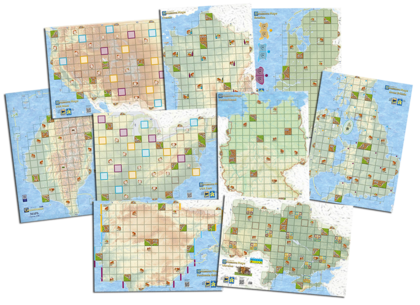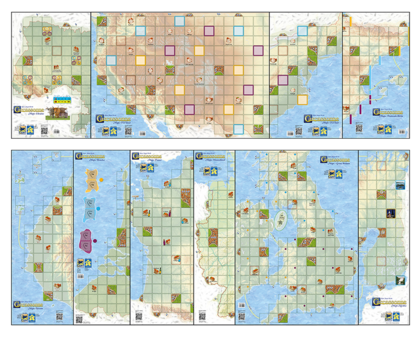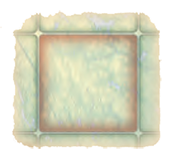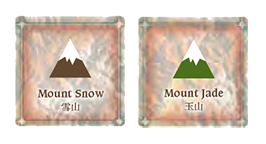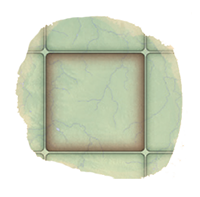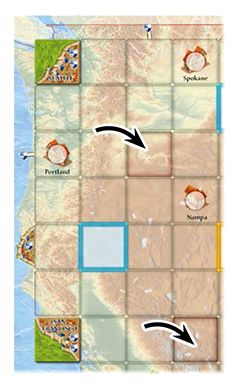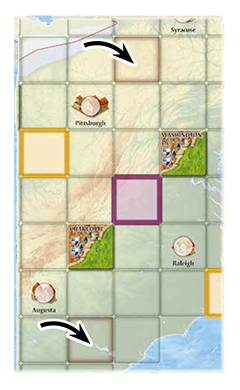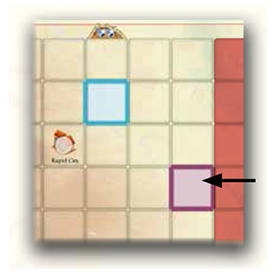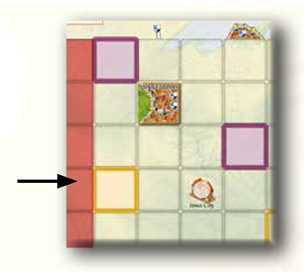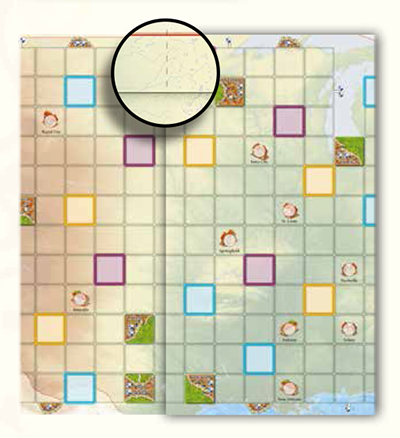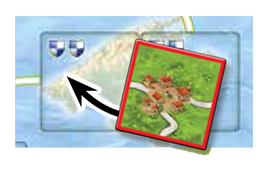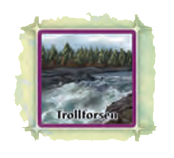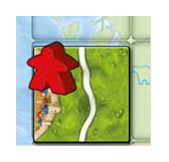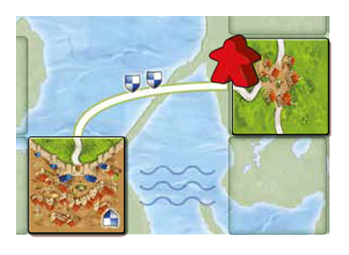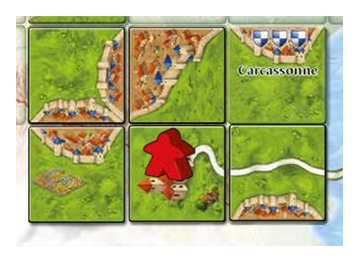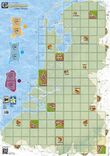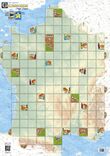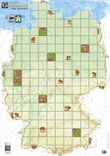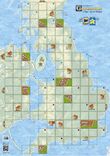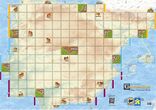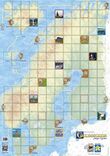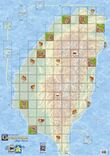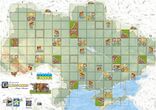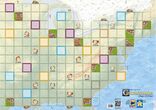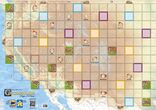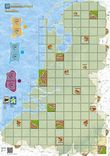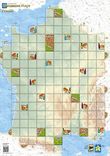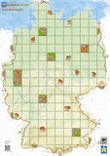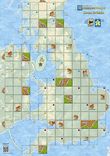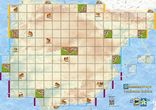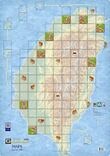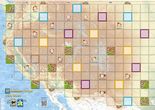Carcassonne Maps - Basic Rules
General info and comments
Carcassonne Maps was originally released by HiG in 2019 starting with the map of Germany. Later the same year, additional maps were released: Benelux, France, Great Britain and the Iberian Peninsula (titled Península Ibérica). They were followed by two more maps in 2020: USA East and USA West.
Additionally, Swan Panasia released the map of Taiwan in 2021. In 2022, Swan Panasia also released the other 7 maps available from HiG. These maps include the names of the cities in Chinese, so they are an adapted version of the original ones. These changes do not affect the rules.
In 2022, HiG released the maps of Ukraine and Taiwan. Until this point all of the maps followed the second edition style (C2).
In 2023, HiG released the map of Nordic countries, named Nordics, in the third edition (C3) along with all of the other maps converted into this edition. [1]
Carcassonne Maps provide a variant for the new edition that offers players a new possibility to play Carcassonne by placing tiles on a map. HiG suggest some rules variations, but encourage players to design their own too.
Contents
- 1 Carcassonne Map (or 2 Carcassonne Maps if combining the USA Maps).
- In addition, you need:
- Tiles: It is recommended to play with the basic game tiles and the first and second expansions, that is,
 Exp. 1 - Inns & Cathedrals and
Exp. 1 - Inns & Cathedrals and  Exp. 2 - Traders & Builders (for up to 114 tiles). [2] If using a
Exp. 2 - Traders & Builders (for up to 114 tiles). [2] If using a  Big Box with the seven Minis, another option is to play with the basic game tiles, the first expansion, that is,
Big Box with the seven Minis, another option is to play with the basic game tiles, the first expansion, that is,  Inns & Cathedrals and Minis #4 to #7 (for up to 120 tiles). [3] Players can combine everything they want to try. For each map there is a recommendation of a number of tiles to be used. It is better to play without the additional rules and meeples of the expansions and to use only the tiles.
Inns & Cathedrals and Minis #4 to #7 (for up to 120 tiles). [3] Players can combine everything they want to try. For each map there is a recommendation of a number of tiles to be used. It is better to play without the additional rules and meeples of the expansions and to use only the tiles.
- The number of tiles recommended for each map differs:
- Benelux: 110-120 tiles
- France: 110-120 tiles
- Germany (Deutschland): 110-120 tiles
- Great Britain: 90-100 tiles
- Iberian Peninsula (Península Ibérica): 110-120 tiles
- Nordics: 115-125 tiles
- Taiwan: 100-110 tiles [4]
- Ukraine: 110-120 tiles
- USA West: 110-120 tiles
- USA East: 110-120 tiles
- USA West + USA East: 220-240 tiles (You will need twice as many tiles.)
- Tiles: It is recommended to play with the basic game tiles and the first and second expansions, that is,
- Meeples: If possible, each player should play with 9 instead of 7 meeples (+ 1 meeple on the scoring board) [5]
Rules
Preparation
Setting up European Maps
There are several start-squares on each map. On each square there is a small town and they are marked with a red edging. You should start with at least 2 start-squares. Take the starting tile (with the darker backside) and one or 2 random tiles and place all of them on 2 to 3 start-squares. You start your game by placing your first tile next to these tiles.
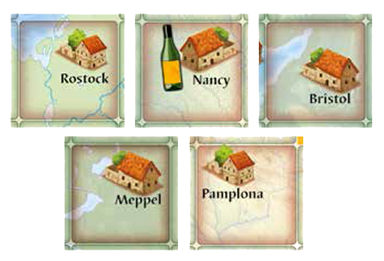
The following table details the number of start-tiles to use for each map: [7]
| Carcassonne Map | Used Start-squares | Total Start-squares |
|---|---|---|
| Benelux | 2 | 3 |
| France | 2 | 3 |
| Germany | 2 | 3 |
| Great Britain | 3 | 3 |
| Iberian Peninsula (Península Ibérica) | 3 | 4 |
If you play after the base game rules and without the Maps-Chips expansion rules, you simply ignore the additional prints on the maps (for example, the wine bottles on the France Map, the colored lines on the Iberian Peninsula Map, islands on the Benelux Map, and so on). The general rules stay the same, and some new rules are added when using the Map-Chips.
(Note: to make it easier to read we will be using the words large city and town even if those words do not always represent reality.)
Setting up the Nordics Map
There are three start-squares on each map. They are marked with a brown edging and you should start with 2 of them. Take the starting tile (with the darker backside) and one random tile, and place them on the 2 chosen start-squares on the map. You start your game by placing your first tile next to these tiles.
If you play after the base game rules and without the Maps-Chips expansion rules, you simply ignore the additional prints on the map except for the highlights. The general rules stay the same, and some new rules are added when using the Map-Chips.
(Note: to make it easier to read we will be using the words large city and town even if those words do not always represent reality.)
Setting up the Taiwan Map
There are two start-squares on the map. On each square there is a mountain and they are marked with a red edging. [8] You should start with these 2 start-squares. Take the starting tile (with the darker backside) and one random tiles and place them on the 2 start-squares. You start your game by placing your first tile next to these tiles.
If you play after the base game rules and without the Maps-Chips expansion rules, you don't have to do anything special. The general rules stay the same, and some new rules are added when using the Map-Chips.
(Note: to make it easier to read we will be using the words large city and town even if those words do not always represent reality.)
Setting up the Ukraine Map
There are three start-squares on each map. They are marked with a brown edging and you should start with 2 of them. Take the starting tile (with the darker backside) and one random tile, and place them on the 2 chosen start-squares on the map. You start your game by placing your first tile next to these tiles.
If you play after the base game rules and without the Maps-Chips expansion rules, you simply ignore the additional prints on the map (for example, the Chumak spaces). The general rules stay the same, and some new rules are added when using the Map-Chips.
(Note: to make it easier to read we will be using the words large city and town even if those words do not always represent reality.)
Setting up USA Maps
There are two start-squares on each map. They are marked with a brown edging and you should start with both of them. Take the starting tile (with the darker backside) and one random tile, and place them on the 2 start-squares on the map. You start your game by placing your first tile next to these tiles.
If you play after the base game rules and without the Maps-Chips expansion rules, you simply ignore the additional prints on the maps. The general rules stay the same, and some new rules are added when using the Map-Chips.
(Note: to make it easier to read we will be using the words large city and town even if those words do not always represent reality.)
Special cases for USA Maps
Playing with only one USA map
If you use only one of the two maps, the half-sized squares on the right side of the USA West Map and on the left side of the USA East Map respectively, are not part of the game. Tiles cannot be placed there.
Playing with both USA maps
You can also play, using both maps at the same time. When doing so, please note the following:
- Slide the USA East Map over the USA West Map until you reach the dotted line and fix them together with adhesive tape.
- As the half-sized squares on the edges of the maps form full-sized squares when using both maps, you may place tiles onto those squares.
- Use twice as many tiles, hence 220-240 tiles. [9]
- Place tiles on all 4 start squares.
- The rules remain the same, but keep in mind, that the two maps form one big map.
Gameplay
1. Placing a tile
You’re only allowed to place a tile on a pre-printed square. As usual, you have to place a tile next to an already placed one.
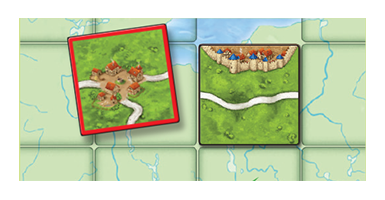
Large cities
On squares with printed large city tiles (for example Berlin, London, Paris, Amsterdam or Barcelona) you cannot place tiles. As soon as you place a tile next to a city tile, it is connected. From now on, everybody can place a tile next to the city tile.
Towns
Squares with towns (with a small house, for example Bremen, Bordeaux, Oxford, Strasbourg, Utrecht, Salamanca...) count as normal squares. You are allowed to place tiles according to the general rules. On some Maps the rules for these tiles differ. You find some variants in section Variants below.
Border squares with adjacent city or road
Wherever there are cities or roads printed on the "border" of the map you have to place a compatible tile.
Border squares without connection
The "border" of the map is neutral which means that you are allowed to place your tile the way you want if there are no pre-printed cities or roads.
Ferry routes (Benelux map, Iberian Peninsula map, Nordics map and Taiwan map)
If you have connected a ferry route with a road, everybody is allowed to continue this connection on the other end of the road.
Waves (Benelux map and Nordics map)
There are three squares marked with waves on the Benelux map. You cannot place a land tile on these squares.
Island squares with coats of arms (Iberian Peninsula map and Taiwan map)
You can only place tiles on island squares on the Iberian Peninsula map if they have been connected with a ferry route from the mainland (see general rules here). If you place a tile on a square with a coat of arms, you'll score 2 points for each coat of arms immediately.
Nordic highlights (Nordics map)
You can't place a land tile onto a highlight. But you can place any tile next to it. Like at a border square, all features are closed at the side of the highlight. When a highlight is discovered at one side, you can't automatically place tiles at the other sides (unlike a printed city). [11]
2. Placing a meeple
After having placed a tile you are allowed to place a meeple according to the general rules.
3. Scoring a feature
A coat of arms [12] gives you 2 additional points in each scoring no matter if it is part of a road or a city.
1) Large cities
If you complete a large city you score according to the general rules. Pre-printed large city tiles are scored in the same way as a normal city tile. Coats of arms give additional points.
2a) Border squares with adjacent city or road
Roads which end on the border are automatically completed there. Pre-printed roads or cities are scored as normal tiles. Coats of arms give additional points.
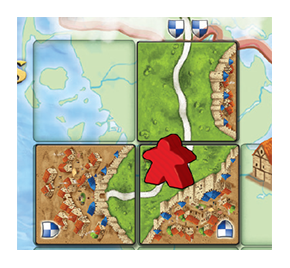
2b) Border squares without a connection
A city, road or field placed on the border (next to clouds or the sea) is seen as completed. You score them according to the normal rules.
3) Ferry Routes
A ferry route gives you 1 point for the road plus the additional points for the coats of arms on this connection. They are scored when the road is completed.
4) Monastery on the border
To complete and score a monastery on the border it isn't necessary to place 8 adjacent. Only the surrounding squares (also the diagonal ones) have to be filled with tiles. However, only "real" tiles as well as pre-printed large cities are scored. [13]
Final Scoring
As usual, city tiles and coats of arms of cities or roads which haven't been completed score only 1 point each. Coats of arms of uncompleted roads which end in neighboring countries also score 1 point.
 Variants
Variants
Towns
You can try using the following additional rules for the town squares:
- Placing a tile on top of a town grants you one extra turn immediately. You may only obtain 1 extra turn this way while it is your turn.
- Placing a tile on top of a town costs 2 points.
- When scoring a road, you get 2 bonus points for each town which is still visible and touches your road (horizontally or vertically).
Tile distribution
C3 Edition
![]() Carcassonne Map: Great Britain
Carcassonne Map: Great Britain
![]() Carcassonne Map: Iberian Peninsula (Península Ibérica)
Carcassonne Map: Iberian Peninsula (Península Ibérica)
C2 Edition
![]() Carcassonne Map: Great Britain
Carcassonne Map: Great Britain
![]() Carcassonne Map: Iberian Peninsula (Península Ibérica)
Carcassonne Map: Iberian Peninsula (Península Ibérica)
Footnotes
For Icons explanation and licensing please visit Icons page.
- ↑
 This C3 version of the maps include some minor changes and also corrections to some issues previous C2 print runs:
This C3 version of the maps include some minor changes and also corrections to some issues previous C2 print runs:
- Germany:
- Changes (following the lead of the changes included in the Swan Panasia edition in 2022):
- Rostock changed to Wismar (town name in a start-square)
- Ruhrgebiet changed to Essen + Köln (different names used for the same large city printed tiles)
- Corrections:
- Correction of road to Poland overlapping coat of arms.
- Changes (following the lead of the changes included in the Swan Panasia edition in 2022):
- Taiwan:
- Changes:
- Addition of towns missing in the initial version by HiG: Yunlin and Miaoli
- Renaming of the Pescadores islands to Penghu, following the version released by Swan Panasia.
- Inclusion of the original mounts (Mount Snow and Mount Jade) in the start-squares present in the edition by Swan Panasia but later removed by HiG.
- Corrections:
- Renaming of one of the Lienchiang islands to Dongyin (the name was duplicated by mistake), following the version released by Swan Panasia in 2022.
- Changes:
- Ukraine:
- Corrections:
- Correction of typo affecting Tscherkassy.
- Corrections:
- USA West:
- Corrections:
- Correction of typos affecting Albuquerque, San Antonio and Amarillo.
- Renaming of Toledo to Ely.
- Corrections:
- Germany:
- ↑
 This represents (72 + 18 + 24 =) 114 tiles, as indicated by the original rules for Carcassonne Maps - Germany.
This represents (72 + 18 + 24 =) 114 tiles, as indicated by the original rules for Carcassonne Maps - Germany.
- ↑
 This represents (72 + 18 + 8 + 8 + 8 + 6 =) 120 tiles, as indicated for Carcassonne Maps - Nordics.
This represents (72 + 18 + 8 + 8 + 8 + 6 =) 120 tiles, as indicated for Carcassonne Maps - Nordics.
- ↑
 The Taiwan Map page on CundCo suggests to use 100-110 tiles due to its smaller size.
The Taiwan Map page on CundCo suggests to use 100-110 tiles due to its smaller size.
The Taiwan Map rules suggest to use 125-130 tiles including the same expansions as the other maps, so this seems to be a mistake. Besides, the Taiwan Map only has room for 121 tiles. - ↑
 If you need additional meeples: you can order sets with 2 extra normal meeples in each colour in the cundco.de webshop.
If you need additional meeples: you can order sets with 2 extra normal meeples in each colour in the cundco.de webshop.
- ↑
 Note that Rostock has been replaced by Wismar in the latest versions of the German Map: C2 version by Swan Panasia and C3 version by HiG.
Note that Rostock has been replaced by Wismar in the latest versions of the German Map: C2 version by Swan Panasia and C3 version by HiG.
- ↑
 These are the same figures required for each Map-Chip expansion.
These are the same figures required for each Map-Chip expansion.
- ↑
 The C2 version of the Taiwan map released by HiG in 2022 didn't include the mounts in the start-squares. However, the C3 version did include them, following the lead of the version released by Swan Panasia.
The C2 version of the Taiwan map released by HiG in 2022 didn't include the mounts in the start-squares. However, the C3 version did include them, following the lead of the version released by Swan Panasia.
- ↑
 Use 250-270 tiles when playing with the two maps together to ensure the central part is not left empty. (Thanks to corinthiens13.)
Use 250-270 tiles when playing with the two maps together to ensure the central part is not left empty. (Thanks to corinthiens13.)
- ↑ Jump up to: 10.0 10.1
 This example assumes you are playing with the Germany map.
This example assumes you are playing with the Germany map.
- ↑
 A monastery adjacent to a Nordic highlight will not consider it for its scoring. The space occupied by the highlight is considered as a border of the map.
A monastery adjacent to a Nordic highlight will not consider it for its scoring. The space occupied by the highlight is considered as a border of the map.
- ↑
 The first versions of the English manuals released by CundCo used "emblems" instead of "coat of arms" throughout the rules.
The first versions of the English manuals released by CundCo used "emblems" instead of "coat of arms" throughout the rules.
- ↑
 Pre-printed city and road segments abroad as well as pre-printed ferry routes and Nordic highlights are not taken into consideration when scoring a monastery. Therefore, monastery scoring only takes into consideration:
Pre-printed city and road segments abroad as well as pre-printed ferry routes and Nordic highlights are not taken into consideration when scoring a monastery. Therefore, monastery scoring only takes into consideration:
- Regular land tiles, as per the normal rules
- Pre-printed large city tiles that may be adjacent to the monastery
- Roads consider regular tiles, pre-printed large city tiles with roads, pre-printed road segments abroad and ferry routes.
- Cities consider regular tiles, pre-printed large city tiles and pre-printed city segments abroad.
- Monasteries consider regular tiles and pre-printed large city tiles.
Feature Regular Feature Tile Pre-printed Large City Tile Pre-printed Feature Segment Abroad Pre-printed Ferry Route Nordic highlight Road (road segment) (road segment) City (city segment) Monastery
